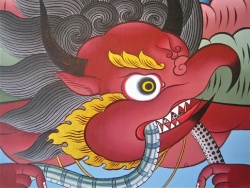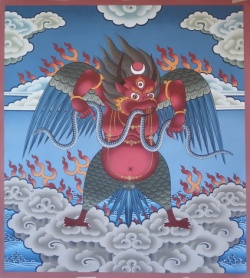Difference between revisions of "Garuda a bird creature"
| (6 intermediate revisions by 3 users not shown) | |||
| Line 1: | Line 1: | ||
[[File:Garuda14.jpg|thumb|250px|]] | [[File:Garuda14.jpg|thumb|250px|]] | ||
<poem> | <poem> | ||
| − | A | + | A [[Garuda]] is a bird creature of [[Buddhist mythology]] that combines the features of [[Gods]] and [[Animals]]. The [[Dhyani]] [[Buddha]] [[Amoghasiddhi]] sometimes is pictured riding a [[Garuda]]. |
| − | The | + | The [[Garuda]] first appeared in [[Hinduism]], where they were pictured as [[humans]] with wings and beaks. In [[Buddhist]] {{Wiki|iconography}} the [[Garuda]] is more birdlike. |
| − | In Tibetan Buddhism, the | + | In [[Tibetan Buddhism]], the [[Garuda]] is one of the [[Four Dignities]] -- [[Animals]] that represent [[characteristics]] of a [[Bodhisattva]]. The four [[Animals]] are the [[dragon]], representing [[Power]]; the [[tiger]], representing [[confidence]]; the [[Snow Lion]], representing [[fearlessness]]; and the [[Garuda]], representing [[Wisdom]]. |
| − | Garudas are the enemies of | + | [[Garudas]] are the enemies of [[Nagas]]. In the [[Maha-Samaya Sutta]] of the [[Pali Canon]], The [[Buddha]] makes [[Peace]] between [[Nagas]] and [[garudas]]. |
| − | Garuda (Skt. garuḍa; Tib. & Wyl. khyung) – a mythical bird-like creature symbolizing various elements of the Buddhist | + | [[Garuda]] (Skt. [[garuḍa]]; Tib. & [[Wyl.]] [[khyung]]) – a [[mythical]] bird-like creature [[symbolizing]] various [[elements]] of the [[Buddhist]] [[Path]]. |
Overview | Overview | ||
| − | The | + | The [[Garuda]] [[Symbol]] can have the following meanings: |
| − | A mythical creature | + | A [[mythical]] creature |
| − | One of the four dignities associated with the windhorse | + | One of the [[four dignities]] associated with the [[windhorse]] |
| − | A | + | A [[Deity]] of [[protection]] |
| − | Our primordial nature | + | Our [[primordial nature]] |
| + | [[File:Garuda85.JPG|thumb|250px|]] | ||
| + | A [[Mythical]] Creature | ||
| − | + | On the outer level, the [[Garuda]] is a [[mythical]] {{Wiki|semi-divine}} bird-like creature that is the enemy of the [[Nagas]]. It is represented in both [[Hindu]] and [[Buddhist traditions]] (especially in [[Tibetan]], [[Cham]], {{Wiki|Khmer}} and Javan [[Art]]). In the [[Tibetan]] [[Vajrayana]] [[tradition]], the [[Garuda]] was associated with the [[khyung]], which are important [[Deities]] of the [[Bön]] {{Wiki|pantheon}}, and practised during [[Healing]] [[Rituals]] in order to counter certain illnesses provoked by [[Nagas]]. | |
| + | One of the [[Four Dignities]] | ||
| − | + | The [[Garuda]] is also one of the [[four dignities]] associated with the [[windhorse]]. In this context, the [[Garuda]] represents the [[Fire]] [[element]], and it is said to to [[symbolize]] freedom from [[Wikipedia:Hope|hopes]] and {{Wiki|fears}}. | |
| − | + | [[Deity]] of [[protection]] | |
| − | + | [[Garuda]] is also an important [[Deity]] of [[protection]]. For example: | |
| − | |||
| − | + | It is one of the Three [[Deities]] of the [[Great Master]] [[Vajrapani]] | |
| + | It is depicted above [[Vajrakilaya]] in [[Vajrakilaya]] [[thangkas]] | ||
| + | The practice of [[Takhyung Barwa]] combines the practices of [[Hayagriva]], [[Guru]] [[Drakpo]], and [[Garuda]]. | ||
| + | [[File:Garuda36.JPG|thumb|250px|]] | ||
| + | Our [[Primordial Nature]] | ||
| − | + | In the [[Dzogchen]] teachings, the [[Garuda]] represents our [[primordial nature]]. [[The Tibetan Book of Living and Dying]] says: | |
| − | |||
| − | |||
| − | + | The [[Dzogchen]] [[Tantras]], the {{Wiki|ancient}} teachings from which the [[Bardo]] instructions come, speak of a [[mythical]] bird, the [[Garuda]], which is born fully grown. This image [[symbolizes]] our [[primordial nature]], which is already completely perfect. The [[Garuda]] chick has all its wing feathers fully developed inside the egg, but it cannot fly before it hatches. Only at the moment when the shell cracks open can it burst out and soar into the sky. Similarly, the [[masters]] tell us, the qualities of [[Buddhahood]] are [[veiled]] by the [[Body]], and as soon as the [[Body]] is discarded, they will be radiantly displayed | |
| − | + | [[GARUDA]] is the [[king]] of birds. Its [[Name]] derives from the [[root]] Gri, to swallow: [[GARUDA]] devours the {{Wiki|snakes}}. He is represented with a [[human]] upper [[Body]], big [[Eyes]], beak, short blue horns, yellow [[Hair]] [[standing]] on end, bird's claws and wings. However, sometimes, mainly in [[Hindu]] {{Wiki|iconography}}, he is represented in [[human]] [[Form]] with wings. | |
| − | + | [[GARUDA]] is a very big bird and comes out of the egg fully grown. [[GARUDA]] [[symbolizes]] [[the space element]] and the Power of the {{Wiki|sun}}, which can dry up the waters. Therefore he is the natural enemy of {{Wiki|snakes}} and he devours or controls them. He represents the [[Spiritual]] [[energy]] of which devours the [[delusions]] of [[jealousy]]. And [[hatred]], which are represented by the {{Wiki|snake}}. [[GARUDA]] is also the [[openness]]: he can stretch out his wings and soar into [[space]]. He represents the great fresom of the [[MIND]] which can open and is not uptied by confliction [[emotions]] the [[wise]] [[MIND]] which reaches every where, like the [[rays of the sun]], and brings about the growth of [[Life]] and [[Wisdom]]. Specifically in [[BUDDHISM]] [[GARUDA]] is related of the [[perfection]] of gibing [[dana paramita]], just as the [[rays of the sun]] give [[Life]] to the [[Earth]]. | |
| + | |||
| + | The [[myth]] of the great bird devouring the {{Wiki|snake}} seems to have originated in {{Wiki|Mesopotamia}}. The {{Wiki|snake}} represents the {{Wiki|subconscious}} or hidden aspects of the [[MIND]], those [[feelings]] and [[thoughts]] which crawl underneath the surface. [[GARUDA]] can {{Wiki|perceive}} any tiny {{Wiki|snake}} and instantly fall upon in. Similarly, by practicing [[awareness]] of all our [[feelings]], [[thoughts]] and [[actions]] we can develop the [[Wisdom]] which can {{Wiki|perceive}} perfectly the workings of our [[MIND]] and in that way we can achieve complete freedom to act utilizing out [[MIND]] in the most beneficial way. | ||
| + | |||
| + | In [[Hindu]] {{Wiki|Iconography}} [[GARUDA]] is the [[vehicle]] of [[Vishnu]]. In BUDDHISM, he is the [[vehicle]] of [[Amoghasiddhi]], The [[Buddha]] who [[embodies]] the all accomplishing [[Wisdom]]. He is also the [[vehicle]] of a from of Lokishvara Hariharihar [[vahana]]. [[GARUDA]] is also a [[Deity]] of his own who is supposed to cure snakebite, {{Wiki|epilepsy}} and {{Wiki|diseases}} [[caused]] by [[Nagas]]. An image of [[GARUDA]] is found in the toranas, the semicircular tympanum above the [[temple]] doors. | ||
| + | |||
| + | The {{Wiki|emerald}}, also called [[GARUDA]] stone is considered a [[Protection]] against [[poison]] and [[GARUDA]] images appear in Jewellery as a [[Protection]] against {{Wiki|snake}} bite. | ||
</poem> | </poem> | ||
{{R}} | {{R}} | ||
Latest revision as of 04:27, 7 April 2014
A Garuda is a bird creature of Buddhist mythology that combines the features of Gods and Animals. The Dhyani Buddha Amoghasiddhi sometimes is pictured riding a Garuda.
The Garuda first appeared in Hinduism, where they were pictured as humans with wings and beaks. In Buddhist iconography the Garuda is more birdlike.
In Tibetan Buddhism, the Garuda is one of the Four Dignities -- Animals that represent characteristics of a Bodhisattva. The four Animals are the dragon, representing Power; the tiger, representing confidence; the Snow Lion, representing fearlessness; and the Garuda, representing Wisdom.
Garudas are the enemies of Nagas. In the Maha-Samaya Sutta of the Pali Canon, The Buddha makes Peace between Nagas and garudas.
Garuda (Skt. garuḍa; Tib. & Wyl. khyung) – a mythical bird-like creature symbolizing various elements of the Buddhist Path.
Overview
The Garuda Symbol can have the following meanings:
A mythical creature
One of the four dignities associated with the windhorse
A Deity of protection
Our primordial nature
A Mythical Creature
On the outer level, the Garuda is a mythical semi-divine bird-like creature that is the enemy of the Nagas. It is represented in both Hindu and Buddhist traditions (especially in Tibetan, Cham, Khmer and Javan Art). In the Tibetan Vajrayana tradition, the Garuda was associated with the khyung, which are important Deities of the Bön pantheon, and practised during Healing Rituals in order to counter certain illnesses provoked by Nagas.
One of the Four Dignities
The Garuda is also one of the four dignities associated with the windhorse. In this context, the Garuda represents the Fire element, and it is said to to symbolize freedom from hopes and fears.
Deity of protection
Garuda is also an important Deity of protection. For example:
It is one of the Three Deities of the Great Master Vajrapani
It is depicted above Vajrakilaya in Vajrakilaya thangkas
The practice of Takhyung Barwa combines the practices of Hayagriva, Guru Drakpo, and Garuda.
Our Primordial Nature
In the Dzogchen teachings, the Garuda represents our primordial nature. The Tibetan Book of Living and Dying says:
The Dzogchen Tantras, the ancient teachings from which the Bardo instructions come, speak of a mythical bird, the Garuda, which is born fully grown. This image symbolizes our primordial nature, which is already completely perfect. The Garuda chick has all its wing feathers fully developed inside the egg, but it cannot fly before it hatches. Only at the moment when the shell cracks open can it burst out and soar into the sky. Similarly, the masters tell us, the qualities of Buddhahood are veiled by the Body, and as soon as the Body is discarded, they will be radiantly displayed
GARUDA is the king of birds. Its Name derives from the root Gri, to swallow: GARUDA devours the snakes. He is represented with a human upper Body, big Eyes, beak, short blue horns, yellow Hair standing on end, bird's claws and wings. However, sometimes, mainly in Hindu iconography, he is represented in human Form with wings.
GARUDA is a very big bird and comes out of the egg fully grown. GARUDA symbolizes the space element and the Power of the sun, which can dry up the waters. Therefore he is the natural enemy of snakes and he devours or controls them. He represents the Spiritual energy of which devours the delusions of jealousy. And hatred, which are represented by the snake. GARUDA is also the openness: he can stretch out his wings and soar into space. He represents the great fresom of the MIND which can open and is not uptied by confliction emotions the wise MIND which reaches every where, like the rays of the sun, and brings about the growth of Life and Wisdom. Specifically in BUDDHISM GARUDA is related of the perfection of gibing dana paramita, just as the rays of the sun give Life to the Earth.
The myth of the great bird devouring the snake seems to have originated in Mesopotamia. The snake represents the subconscious or hidden aspects of the MIND, those feelings and thoughts which crawl underneath the surface. GARUDA can perceive any tiny snake and instantly fall upon in. Similarly, by practicing awareness of all our feelings, thoughts and actions we can develop the Wisdom which can perceive perfectly the workings of our MIND and in that way we can achieve complete freedom to act utilizing out MIND in the most beneficial way.
In Hindu Iconography GARUDA is the vehicle of Vishnu. In BUDDHISM, he is the vehicle of Amoghasiddhi, The Buddha who embodies the all accomplishing Wisdom. He is also the vehicle of a from of Lokishvara Hariharihar vahana. GARUDA is also a Deity of his own who is supposed to cure snakebite, epilepsy and diseases caused by Nagas. An image of GARUDA is found in the toranas, the semicircular tympanum above the temple doors.
The emerald, also called GARUDA stone is considered a Protection against poison and GARUDA images appear in Jewellery as a Protection against snake bite.


